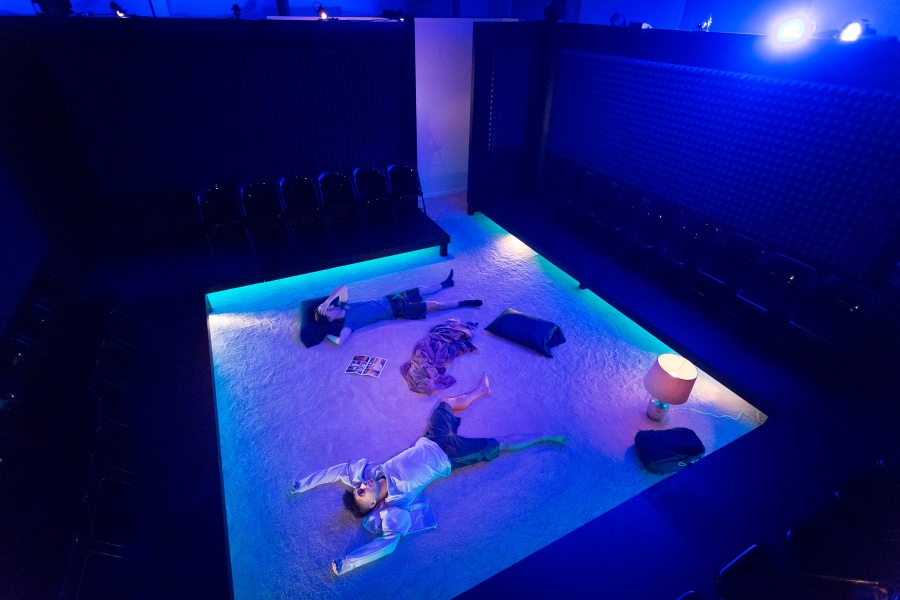NEW YORK CITY: It seems these days, you can’t walk down the streets of New York without running into a theatre company. Within the countless array of theatrical offerings, one group is looking to make its mark: New Light Theater Project, located in Washington Heights in Northern Manhattan. The collaborative company provides a space and platform for resident arts to create and produce new works. We caught up with founding artistic director Sarah Norris and founding producing director Michael Aguirre to learn about how they make sure New Light is different from the rest.
Who founded the company, when, and why?
New Light Theater Project (NLTP) was established in 2013 by founding members Sarah Norris, Michael Aguirre, Amanda Berry, and Chris Ryan. Over the course of a few months, we formed an informal play-reading group and would gather at Sarah’s apartment on Sunday mornings to read pages and munch on pancakes. Other awesome artists participated in those initial gatherings, but we were the consistent faces. We realized between the four of us, we knew hundreds of talented artists and companies in NYC, so we decided to plan an event/party that brought those people together.
This idea for an ‘Arts Party’ morphed into our Darkroom Series, and the impetus of this program remains the same—to share our resources (space, inventory, social media platforms, etc.) with other artists while celebrating new work. Darkroom has provided a stage and networking platform for more than 2,000 artists and theatregoers over the last five years. This sharing of resources is key to New Light’s mission and our core belief that the indie theatre community can only grow by supporting each other.
Tell us about yourself and your connection to New Light Theater Project.

NORRIS: My name is Sarah Norris and I’m the founding artistic director of New Light Theater Project. Originally from Huntsville, Ala., I came to NYC after graduating college in 2002, and have been pursuing a life in theatre ever since.
I feel like theatre artists nowadays wear a lot of ‘hats’ and I’m no exception. For me, this is one of the most exciting aspects of living in NYC as an artist. I have an MFA in directing, but I’m also passionate about producing, and I’ve done a little dabbling in acting, writing, and stage management as well.

AGUIRRE: My name is Michael Aguirre and the I’m founding producing director of New Light Theater Project. I’m from a suburb of Chicago called Elmhurst and made my way to New York City via Bloomington, Ind., to Philadelphia, back to Chicago, then to New York.
I’ve had the privilege of working with Steppenwolf, Chicago Dramatists, and First Folio in Chicago. Regionally, I’ve worked with the Wilma Theater in Philadelphia, the Hexagon Theatre in South Africa, and the Pearl Theatre and Signature Theatre in NYC.
What sets your theatre apart from others in New York City?
New Light’s productions strive to capture the Little Theatre Movement (artistry over commerce; producing new and classic works) in the NYC theatre community. This aspiration reflects the multiplicity of New York City, on and off stage, and our production history ranges from small cabaret-style revues to full-fledged musicals, intimate living room dramas to abstract movement-based plays. We don’t produce any one genre but welcome a broad range of plays and musicals that represent the diversity within our company and community. New Light is comprised of an eclectic mix of resident artists (writers, directors, actors, designers, stage managers) so we gravitate toward pieces that showcase their talents, with opportunities to welcome new collaborators so the company continues to grow.
Who is your audience?
Our main audience is the downtown New York theatre crowd. They’re an ambitious crew, always on the hunt for new plays, bold artists, big ideas. Our audience sees a lot of shows around the city, and they’re quick to respond if the work speaks to them—or if it doesn’t. But overall, they are champions of the theatre.
How do you pick the plays you put on your stage?
Typically, we look at our resident artists for scripts first; either our writers provide a new play or our artists recommend scripts that speak to them. If we don’t have a piece that excites the company, we seek out ambitious outside writers.
The New Light New Voices Award (NLNV) was launched in 2016 as a means to expand our network of writers. This development platform was designed to support unique theatre voices pursuing a premiere NYC production that features the New Light ensemble. The first NLNV winner, Anne Adams’ Strange Country, was produced to critical acclaim, and was followed by Dan Giles’ Breeders (which was a Time Out New York critics’ pick) last fall. The award offers a full-scale production to dynamic playwrights in the community; aligning with our mission of outside collaboration by extending beyond New Light’s network of artists.
What’s your annual budget, and how many artists do you employ each season?
Our projected budget for next season is $150,000 and we employ about 40-50 artists per year.
What show are you working on now? Anything else in your season that you’re especially looking forward to?
Hal & Bee, a new dark comedy by Max Baker that Sarah is directing, runs through March 31 at 59E59 Theaters, and is a coproduction with our friends at Stable Cable Lab Co. Following that, the hollower by Liza Birkenmeier premieres at our old stomping ground at Access Theater in downtown Manhattan (running May 18-June 9). The production will be Liza’s first big run in NYC and we’re thrilled to be bringing her show to life!
Strangest or funniest thing you’ve ever seen (or put) on your stage?
At our very first Darkroom, an actor onstage randomly got a bloody nose and it wasn’t a little trickle, there was blood all over the stage! Instead of stopping mid-scene, he took his shirt off, shoved it against his face, and continued with the piece as his nose continued to bleed.
Looking back, we probably should have stopped the show for sanitary/health reasons. But the audiences LOVED it. We’ve never seen an actor get a bigger standing ovation.

What are you doing when you’re not doing theatre?
Norris: I volunteer with iMentor, a program in New York City that pairs a professional with a high school student to serve as a mentor. My mentee is 14 year old Ally from Washington Heights and I will work with her over the next four years during her high school career. Ally wants to be a singer and an engineer for bridges, and her long-term goal is to attend an Ivy League school. The program is pretty special; I’m inspired daily by Ally and her passion for life and her eagerness to learn and find her place in the world.
Aguirre: About 15 hours a week, I tutor adults who are seeking their high school diploma. Many of my students are immigrants and some of the hardest-working people I’ve ever met, doing thankless work at minimum wage. They inspire and motivate my work as an artist. They are voices we don’t hear often enough in the theatre.
What does theatre—not just your theatre, but the American or world theatre—look like in, say, 20 years?
Alive. Political. Diverse. Necessary. There are huge strides being made in our industry, addressing gender parity and racial imbalance in the theatre and world— we believe in 20 years, the theatre will continue to be leaders in this movement. Theatre artists and organizations will remain at the forefront of challenging audiences and presenting difficult, necessary questions for society to recognize and hopefully, spark change.
We’ve heard the same mantra for years, “the theatre is a dying art form,” and we don’t agree with that statement anymore. Some of the hardest working, smartest, and most talented people we know are in this business, and we don’t see them slowing down any time soon.


